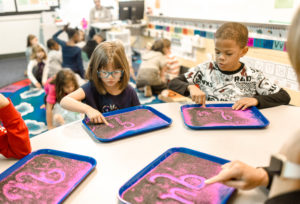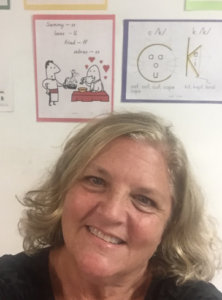Phonemic Awareness
Scavenger Hunt: Tell your child to find an item that begins with /s/ (say the sound, not the letter) and see if she can find an object that begins with that sound. Do five sounds. After the 5thone, review each object and it’s beginning sound. Keep the items together. The next day, do five more sounds. At the end of the 5thsound review all ten items. Continue with 5 sounds each day and review all the sounds done before. For younger children, you could gather all the items and put them in a room instead of having them run around the house looking for objects. This could also be done outdoors.
*They will not be able to find an item that begins with x.
Elimination Part 1: Choose items from around the house or yard (two with the same beginning sound and one with a different beginning sound.) Put the items down in front of your child and ask him to tell you the name of each object. Then have him remove the item that does not have the same beginning sound.
*For example, spoon, ring, sock – remove the ring.
Elimination Part 2: Same as part one except for this time use items with the same ending sound.
*For example, fork, book, cup – remove the cup.
The ABC’s
ABC Pass: Toss a ball back and forth while saying the alphabet. If you miss the ball, try to start the alphabet where you left off instead of going back to the beginning. Start with a different person each time so that everyone says different letters.
ABC Jump: Jump from one foot to the other as you say the ABC’s. Try to get a little faster each time but don’t leave out a letter.
*Alternative – say the ABC’s while jumping rope

ABC Clap: Face your partner. Say the ABC’s while clapping hands. Right hand to right hand, say “A”. Then left hand to left hand, “B”. Try to get faster each time you say it but don’t leave out a letter.
Texture writing: Call out a sound and have your child write the letter for the sound in a plate of sand, rice, salt or sugar. Have them repeat the sound before they write it. As they write it, they should say the letter and sound (m says /m/). Write lower case letters.
Rhyming
Rhyme walk: Choose a letter sound (consonants only but avoid x). As you walk around, change the beginning sound of items you see to the sound you have chosen. (for example, if you chose /b/, you would say: door – boor, car – bar, tree – bree). This could also be done indoors (table – bable, sink – bink). It is ok if it is not a real word. The goal is for them to be able to change the beginning sound.
What’s that Rhyme?: Say a sentence and see if they can fill in the blank with a rhyming word. (For example, there’s a bee in that _____ (tree), Oh my word, there’s a black____(bird), 2, 3, 4, 2, 3, 4, I need you to close the ____(door). When beginning this activity, you may have to point to the item; but in time, they should be able to come up with the rhyming word without a clue.
Rhyming Grab: Put some items on the table or floor. Say a word and your child should grab the item that rhymes with the word. For example, put a book, ball, mug, tape, and a cracker on the table. Then you would say: this item rhymes with slacker. Your child should grab the cracker. If two or more people are playing, you could keep score. Get a point for a correct grab but lose a point for an incorrect grab. The item can be put back on the table so that another rhyming word can be used. It is ok to use a nonsense word. For example, this item rhymes with zape. The child should grab the tape.
High Frequency – Red Words
Word Hop: Write red words on pieces of paper or index cards. Show the word and have your child say the word as they jump on both feet then spell the word as they hop from one foot to the other saying one letter at a time. Then jump again as they say the word (jump and say “the”/ hop t, hop h, hop e /jump and say “the”). To make it harder, don’t show the word. Call out the word and then they say it and spell it.
*Alternative: spell words while jumping rope
Word clap: Face your partner. Say a word as you clap hands together. Spell the word while alternating hands (right hands together then left hands together) say the word again and clap both hands.
Word Race: Write words on something that won’t blow away like rocks or paint sticks. Put the words at one end of the yard. Say a word and your child runs down, finds the word, runs back, says it and spells it.
*Alternative – Write the words on sticky notes or pieces of paper and put around the house.
Tic Tac Toe: Draw a tic tac toe grid on a piece of paper. Show your child a word, if they read the word correctly, they can put an x or o on the grid. (with younger children, I usually tell them the word if they miss it and let them put their mark on the grid. With older children, if they miss a word, they miss a turn) The first person with three in a row wins the round. To save paper, I make one grid that can be used over and over. Instead of writing on it, we use pieces of colored paper or tokens (coins or game pieces).
*This can be played with any group of words or the letters of the alphabet.
Summary
We hope you will try some of these activities. Children need to have a strong phonemic awareness, letter sense, high-frequency word knowledge, and rhyming background to become good readers. This can all happen while having fun.
About The Author:

Cindy Brown received her Bachelor of Science in Recreation Studies from Troy University in Troy, Alabama. While working for a Marriot Hotel in Atlanta, Cindy realized she wanted to teach children and decided to return to school. She attended the University of Mobile in Mobile, Alabama, and received her masters in Early Childhood and Elementary Education. She is highly qualified to teach reading to pre-K through eighth grade.
She has been teaching in the public school systems of Alabama for 27 years. During that time, she has taught kindergarten, first and second grade. She has also tutored after school and during the summer for the past 24 years. During her teaching career, she has been the theater coordinator for the Discipline-Based Arts Education Committee, a member of the Problem Solving Team, the teacher representative for the PTA, lead teacher, a mentor for new teachers and student-teacher supervisor. Recently, Cindy became the reading intervention teacher at Rockwell Elementary and works with struggling readers grades K-2nd grade. She has been using the IMSE techniques with her students with great results!
Sign up for our LIVE virtual Orton-Gillingham training! We are now offering half-day, evening, and weekend options to best fit your schedule.
The IMSE approach allows teachers to incorporate the five components essential to an effective reading program into their daily lessons: phonemic awareness, phonics, vocabulary, fluency, and comprehension.
The approach is based on the Orton-Gillingham methodology and focuses on explicit, direct instruction that is sequential, structured, and multi-sensory.
It is IMSE’s mission that all children must have the ability to read to fully realize their potential. We are committed to providing teachers with the knowledge and tools to prepare future minds.
